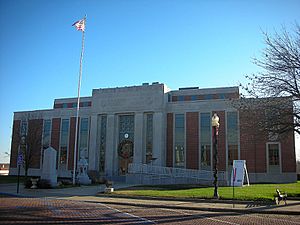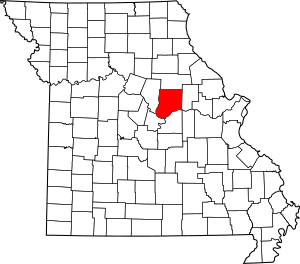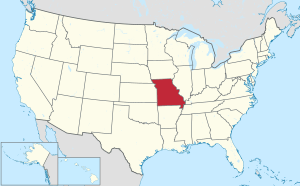Callaway County, Missouri facts for kids
Quick facts for kids
Callaway County
|
|
|---|---|

Callaway County Courthouse in Fulton
|
|

Location within the U.S. state of Missouri
|
|
 Missouri's location within the U.S. |
|
| Country | |
| State | |
| Founded | November 25, 1820 |
| Named for | James Callaway |
| Seat | Fulton |
| Largest city | Fulton |
| Area | |
| • Total | 847 sq mi (2,190 km2) |
| • Land | 835 sq mi (2,160 km2) |
| • Water | 13 sq mi (30 km2) 1.5% |
| Population
(2020)
|
|
| • Total | 44,283 |
| • Density | 52.282/sq mi (20.186/km2) |
| Time zone | UTC−6 (Central) |
| • Summer (DST) | UTC−5 (CDT) |
| Congressional district | 3rd |
Callaway County is a county located in the state of Missouri. In 2020, about 44,283 people lived here. Its main city, or county seat, is Fulton.
The county was started on November 25, 1820. It is named after Captain James Callaway, who was the grandson of the famous explorer Daniel Boone. The Missouri River forms part of the county's border.
Callaway County is often called "The Kingdom of Callaway." This nickname came from an event during the U.S. Civil War. During that time, some local residents stood up to Union troops.
This county is also part of the Jefferson City, Missouri, Metropolitan Statistical Area.
Long ago, in the mid-1800s, German immigrants started growing grapes and making wine here. This tradition is still alive today. The Callaway Nuclear Generating Station, a power plant, is also located in Callaway County, near Fulton.
Contents
History of Callaway County
Early Inhabitants and Settlers
For thousands of years, this area was home to different indigenous peoples. The Osage people were among those who lived here. Some Native American groups moved here from the Ohio River Valley. Others developed their cultures right in this region.
Later, European-American settlers came to Callaway County. Many of them moved from states like Kentucky, Tennessee, and Virginia. They brought their farming traditions with them.
The Kingdom of Callaway
Callaway County was part of an area known as Little Dixie. This region got its name because many settlers came from the Southern states. During the American Civil War, many residents supported the Confederacy.
The only major Civil War battle in Callaway County was the Battle of Moore's Mill. The county's famous nickname, "The Kingdom of Callaway," comes from this time. It refers to an event where local citizens bravely faced Union soldiers.
German Influence and Winemaking
In the mid-1800s, many German immigrants settled in the Missouri River valley. They came after the Revolutions of 1848 in the German states. These immigrants started a strong wine industry in the area. They also built towns with German-style buildings.
Missouri became the second-largest wine-producing state in the U.S. This lasted until Prohibition, when alcohol was banned. Since the 1960s, winemaking has made a comeback. Many vineyards and wineries have opened again, including Summit Lake Winery. Callaway County is part of the "Missouri Rhineland," a region known for its vineyards along the Missouri River.
Geography of Callaway County
Land and Water Features
Callaway County covers about 847 square miles. Most of this area, 835 square miles, is land. The remaining 13 square miles are water.
The county sits where flat prairies meet the rugged Ozarks hills. The northern part of the county is mostly flat with few large forests. The southern part, along the Missouri River, has many large hills and valleys covered in thick forests. Cedar Creek forms the northern part of the county's western border.
Neighboring Counties
Callaway County shares borders with several other counties:
- Audrain County (north)
- Montgomery County (east)
- Osage County (south)
- Cole County (southwest)
- Boone County (west)
- Gasconade County (southeast)
Main Roads
Important highways that run through Callaway County include:
 Interstate 70
Interstate 70 U.S. Route 40
U.S. Route 40 U.S. Route 54
U.S. Route 54 U.S. Route 63
U.S. Route 63 Route 94
Route 94
Protected Natural Areas
Parts of these national protected areas are located in Callaway County:
Climate
|
||||||||||||||||||||||||||||||||||||||||||||||||||||||||||||||||||||||||||||||||||||||||||||||||
Population Information
| Historical population | |||
|---|---|---|---|
| Census | Pop. | %± | |
| 1830 | 6,159 | — | |
| 1840 | 11,765 | 91.0% | |
| 1850 | 13,827 | 17.5% | |
| 1860 | 17,449 | 26.2% | |
| 1870 | 19,202 | 10.0% | |
| 1880 | 23,670 | 23.3% | |
| 1890 | 25,131 | 6.2% | |
| 1900 | 25,984 | 3.4% | |
| 1910 | 24,400 | −6.1% | |
| 1920 | 23,007 | −5.7% | |
| 1930 | 19,923 | −13.4% | |
| 1940 | 23,094 | 15.9% | |
| 1950 | 23,316 | 1.0% | |
| 1960 | 23,858 | 2.3% | |
| 1970 | 25,850 | 8.3% | |
| 1980 | 32,252 | 24.8% | |
| 1990 | 32,809 | 1.7% | |
| 2000 | 40,766 | 24.3% | |
| 2010 | 44,332 | 8.7% | |
| 2020 | 44,283 | −0.1% | |
| U.S. Decennial Census 1790-1960 1900-1990 1990-2000 2010-2020 |
|||
In 2020, the population of Callaway County was 44,283 people. Most residents identified as White. About 4.4% identified as Black or African American.
Religious Groups
Callaway County is sometimes considered to be on the northern edge of the Bible Belt. This means that many people here follow evangelical Protestant religions. The largest religious groups include Southern Baptists, Roman Catholics, and United Methodists.
Education in Callaway County
School Districts
Several school districts serve the students of Callaway County:
- Community R-VI School District
- Fulton 58 School District
- Jefferson City Public Schools
- Mexico 59 School District
- Montgomery County R-II School District
- New Bloomfield R-III School District
- North Callaway County R-I School District
- South Callaway County R-II School District
- Wellsville-Middletown R-I School District
Public Schools
Here are some of the public schools in the county:
- Fulton School District No. 58 – Fulton
- New Bloomfield R-III School District – New Bloomfield
- New Bloomfield Elementary School (Grades PK-6)
- New Bloomfield High School (Grades 7-12)
- North Callaway County R-I School District – Kingdom City
- Hatton-McCredie Elementary School (Grades K-5)
- Williamsburg Elementary School (Grades K-5)
- North Callaway Middle School (Grades 6-8) – Auxvasse
- North Callaway County High School (Grades 9-12)
- South Callaway County R-II School District – Mokane
- South Callaway County Early Childhood Education Center (Grades PK-2)
- South Callaway County Elementary School (Grades 3-5)
- South Callaway County Middle School (Grades 6-8)
- South Callaway County High School (Grades 9-12)
The Missouri School for the Deaf, a state-run school, is also located in Fulton.
Private Schools
- St. Peter Catholic School – Fulton (Grades K-8) – A Roman Catholic school.
- Kingdom Christian Academy – Fulton (Grades PK-8) – A Nondenominational Christian school.
- New Bloomfield Community Christian School – New Bloomfield (Grades PK-6) – A Nondenominational Christian school.
Colleges and Universities
- Westminster College - Fulton - A private, four-year Presbyterian university.
- William Woods University - Fulton - A private, four-year university.
Public Libraries
- Callaway County Public Library
Communities in Callaway County
Cities
- Auxvasse
- Fulton (the county seat)
- Holts Summit
- Jefferson City (mostly in Cole County)
- Mokane
- New Bloomfield
Villages
Unincorporated Communities
These are smaller communities not officially organized as cities or villages:
Townships
- Auxvasse
- Bourbon
- Caldwell
- Calwood
- Cedar
- Cleveland
- Cote Sans Dessein
- East Fulton
- Guthrie
- Jackson
- Liberty
- McCredie
- Nine Mile Prairie
- Round Prairie
- St. Aubert
- Shamrock
- Summit
- West Fulton
Notable People from Callaway County
Many interesting people have come from Callaway County:
- William F. Baker, an engineer who worked on the Burj Khalifa building.
- Morris Frederick Bell, a well-known architect.
- Henry Bellamann, a poet and author.
- Nick Cave, a fabric sculptor and artist.
- Ike Clanton, an old west outlaw.
- John Ferrugia, a journalist.
- Tony Galbreath, a running back in the NFL.
- William Lincoln Garver, an architect, author, and politician.
- Charlie James, a Major League Baseball outfielder.
- John Jameson, who served in the U.S. House of Representatives for Missouri.
- Michael Kim, an ESPN anchor.
- Bake McBride, a Major League Baseball outfielder.
- Ron McBride, a running back in the National Football League.
- Laura Redden Searing, also known as Howard Glyndon, a deaf poet and writer.
- Justin Smith, a former NFL player.
- Helen Stephens, a 1936 Olympic Champion, known as "The Fulton Flash."
Images for kids
See also
 In Spanish: Condado de Callaway para niños
In Spanish: Condado de Callaway para niños






